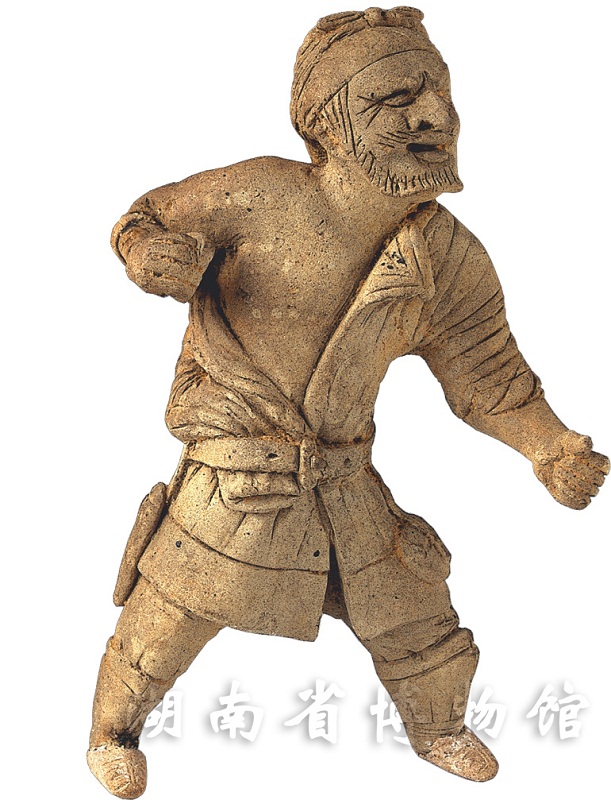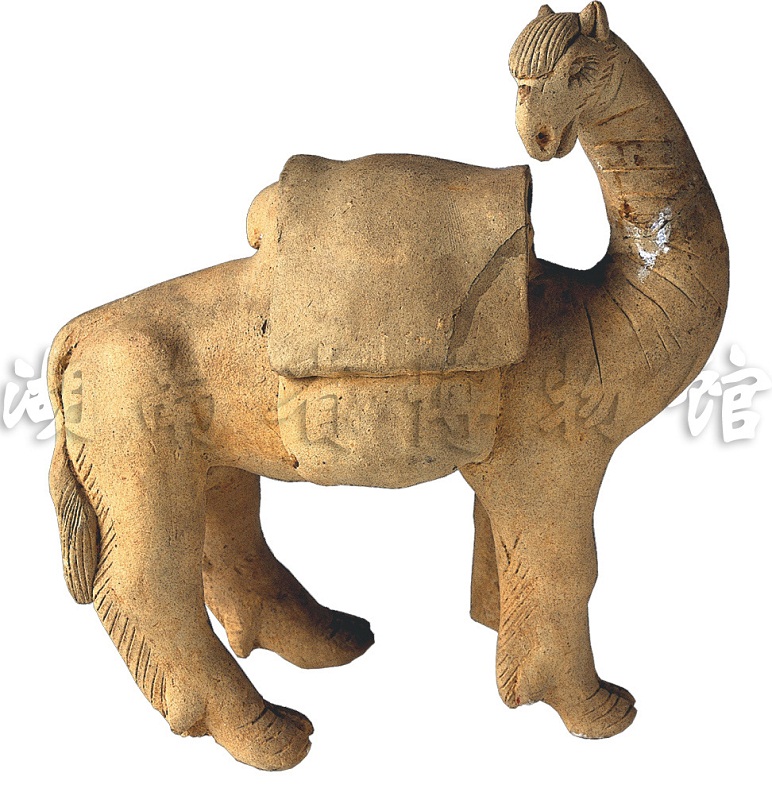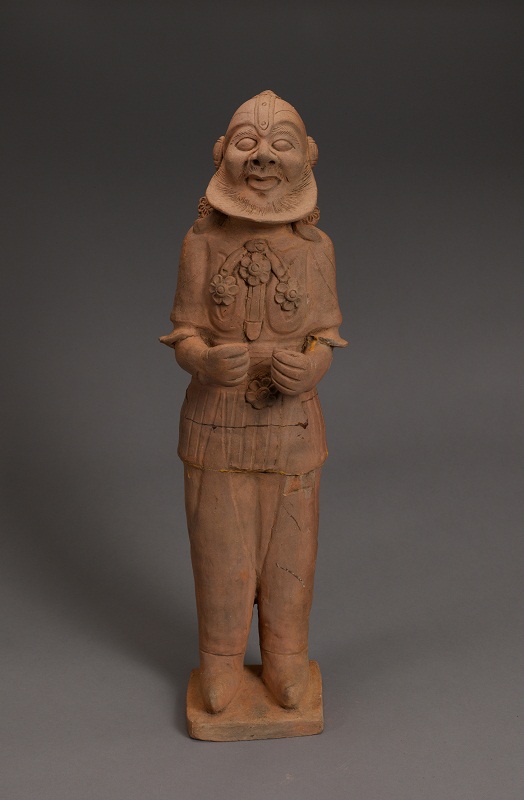Ceramic Camel and Foreign Groom


Tang Dynasty (618—907AD)
Height of Camel: 18.5cm; Length of Camel: 17cm; Height of Groom: 18cm
Excavated from the Tomb in Chigangchong, Changsha City, Hunan Province in 1985
Dressed in a long robe, the figurine wears a cap and a pair of boots, with a belt tied around his waist. He is half bare backed, wearing just one sleeve and leaving the other hanging down loosely around his belt——a habit to deal with the changeable weather from chilly mornings to hot noontimes where they live. His left arm stretches before his chest and right arm bends and raises to lead a camel behind him. Judged from his clothing, big eyes and curled moustache, he is the very image of the foreign people who came from the western Asia through the Silk Road in Tang Dynasty. The ceramic camel stands erect, seems like funny and well-behaved at the same time.
The vivid modeling of the ceramic camel and foreign groom forms a stark contrast in shape between dynamic and static and between virtual and real, thereby reflecting the great vigor of the arts in the Tang Dynasty, and also the prosperous cultural exchanges at that time between China and the West.
深入探索
Cultural Exchanges between China and Arabic & Islamic Countries in Tang Dynasty
The territory of Arab Empire spanned three continents, Asia, Europe and Africa, composed of different nationalities. Inside the Empire, Persia was the nearest to China, so the two countries had the earliest contacts. They established friendly relationship with China in 651. Then in the following 148 years (by 798), Persia sent emissaries to Chang’an for 39 times. Arab emigrants in China were mainly Persian and Omani, mostly living in Guangzhou and Chang’an, some in Yangzhou, Hongzhou and Zhangye. Persian emigrants were good at absorbing excellent parts of foreign cultures, and improved themselves by combining characteristics of their own, thus they were active on the stage of Chinese culture and arts. They played an important role in promoting cultural and art exchanges between China and Iran and the Arab world. Li Shang, Li Xun and Li Shunxian, famous poets of the Tang Dynasty, were all Persian emigrants. The hostess in Huxuan Women, written by Bai Juyi, was a Persian. Iranian ancient literature works, such as Rosary, were widely spread in China, and Islam has used it as canon and listed it as required textbook for hundreds of years. Philosophy of the book was almost the same as Chinese traditional thoughts. Besides, there was much resemblance between much folklore of Tajik and legendary stories of Iran literature, which was obviously the result of mutual influence.
In terms of music, there were many exchanges between China and Iran. China introduced ancient musical instruments such as pipa and flute to Iran, and learned Suona and dulcimer from Iran. There were close relations between Iranian music and that of minorities in Xinjiang. Both used almost the same musical instruments. There was some music both popular in Iran and among minorities of Xinjiang.
Through exchanges between China and countries in the West Regions, fashions from there and other foreign countries had been popular in China from the Han Dynasty to the Tang Dynasty. These figures were of deep eyes and high nose, wearing capuche on head and folded collars; some held Western musical instruments, and some led camels. We could see that they took great pains in traveling through deserts, mountains and hills for economic and cultural exchanges between China and Arab countries.
Ceramic Figure of a Foreigner with a Cane
Height: 27cm
Excavated from Xiangyin County, Hunan Province in 1972
From the collection of Hunan Provincial Museum
Ceramic Figure of a Foreign Groom
Height: 14.9cm
Excavated from Chigangchong, Changsha City, Hunan Province in 1958
From the collection of Hunan Provincial Museum
Ceramic Figure of a Foreigner with a Eagle
Height: 26.3cm
Excavated from Xiajiahu, Changsha City, Hunan Province in 1976
From the collection of Hunan Provincial Museum

Ceramic Figure of a Foreign Warrior
Height: 52cm
Excavated from Huangtuling, Changsha City, Hunan Province in 1956
From the collection of Hunan Provincial Museum

In this period, Chinese papermaking and spinning techniques, painting art, as well as pottery and porcelain were spread into Arab countries and the West. Chinese craftsmen helped the Arabs to establish papermaking workshops in Samarkand, and hence the technique was passed to the Muslim world via Iran. At the same time, Chinese spinning technique was widely spread in Mesopotamia. Chinese fine arts were highly praised by Arab people, promoting their designs of gold and silver instruments. After many pottery and porcelain articles were passed to the Muslim world, Arabs added their favorite designs, and porcelain of Chinese and western combined styles developed prosperously in the heart of the Arab world.



